| The Patent Shaft
& Axletree Company - Take Over After the
acquisition of Monway Works and Old Park Works, the
company continued to prosper under the management of
Thomas Walker.
The local iron ore contained too high a percentage
of phosphorus, for reliable use with traditional
smelters. This problem was overcome in 1879 with the
invention of the Gilchrist-Thomas process, in which the
converter had a lining of dolomite brick. The dolomite
combined with the phosphorus to leave good quality
steel.
The Patent Shaft acquired a furnace using this
process in 1882, but difficulties led to its temporary
abandonment. The company also used Siemens open-hearth
regenerative furnaces, where the waste gases were used
to heat the air for the blast. The furnaces were lined
with refractory dolomite brick to allow them to
efficiently use the local iron ore. They also had
another advantage, they could use scrap.
At this time the company also had four 12 ton
traditional Bessemer converters, and a 12 ton and an 8
ton Bessemer, both lined with dolomite brick. The slag
from the furnaces was sold to Germany for use in
agriculture. In 1885 the company built the world's first steel
bridge at Benares on the Ganges, which used 6,500 tons
of steel, and in 1900 built a 7 span bridge at Natal in
just 2 months. |
|
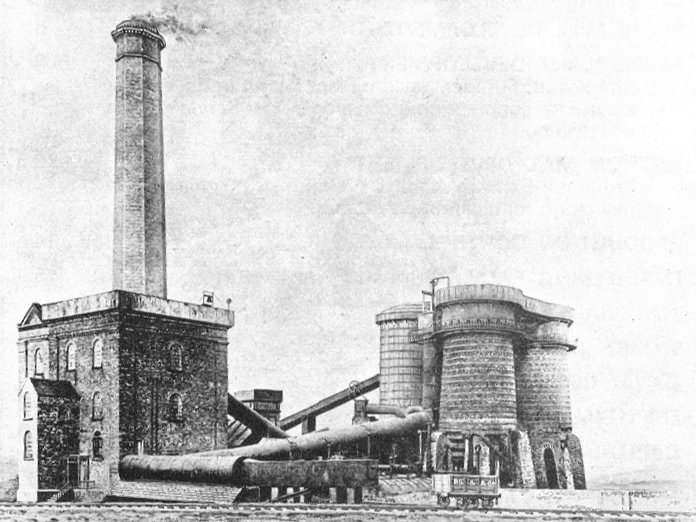
The Patent Shaft blast furnace
in about 1890. |
| The company had some financial difficulties in
the late 1880s and so in 1889 a new company, using
the same name was formed to take over the assets.
The difficulties continued for a few years, during
which time new plant and machinery was added to the
factory. In 1891 work began on a new plate mill, and
a mill for rolling steel channels at Brunswick
works. In 1896 a new cogging mill and soaking pit
were added. All of the new plant continued in use
until 1958/59. |
|

Brunswick Works in about 1895. |
| On the 18th April, 1902, the Patent Shaft
& Axletree Company became part of the Metropolitan
Amalgamated Railway Carriage and Wagon Company
Limited, which had been proposed by Mr. Dudley Docker,
who had joined the Patent Shaft's Board in 1899. The
new company was formed with a share capital of £1.5m
to take over the business of the Metropolitan
Company and to amalgamate with the following rolling
stock companies: The Ashbury
Railway Carriage and Iron Company Limited, Brown and
Marshall's Company Limited, The Lancaster Railway
Carriage and Wagon Company Limited, The
Willingsworth Iron Company Limited and The Oldbury
Railway Carriage and Wagon Company Limited.
The Patent Shaft became became part of a new
conglomerate. From then-on until nationalisation in
1951, the Patent Shaft was wholly owned by the
Metropolitan Company, and was treated as one of its
branches. |
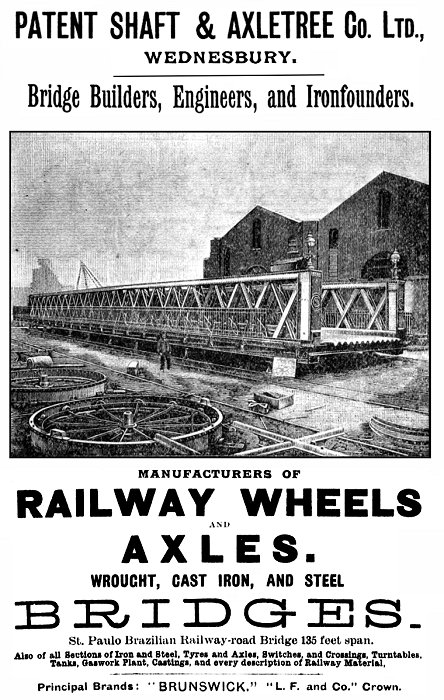
An advert from 1900.
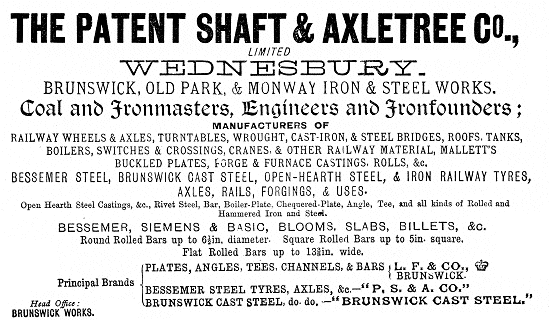
An advert from 1902.
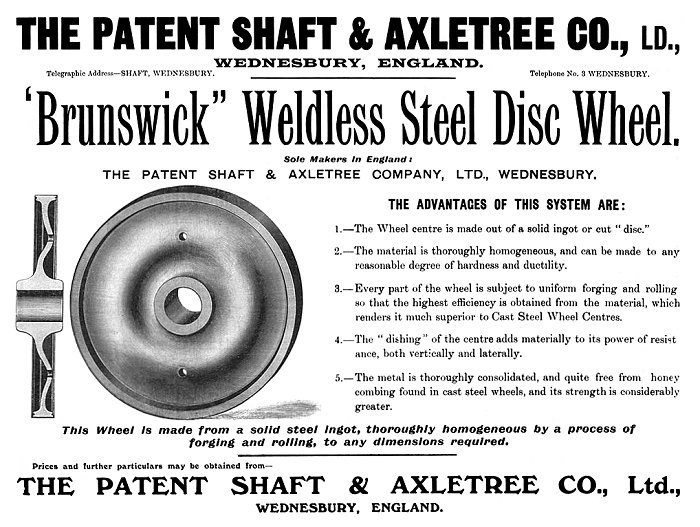
An advert from 1909.
| After the take over a considerable amount of
development work was carried out including new
buildings at Monway Works and Brunswick Works. The
company spent
over £300,000 on the new buildings, and new plant, including electrically
driven machinery. The workforce greatly increased
in size, and the new business prospered. Many of the double-decked trailers that
were pulled by the local steam trams were built at the
works during the early years of the 20th century. |
|

An advert from 1909. |
The business continued to thrive, even during the
severe depression in 1907 when the annual profit was
over £300,000. In 1911 the company received an order
from the Great Central Railway for 6,500 wagons, the
frames for which were made at the Patent Shaft.
At the time, the Patent Shaft
produced a wide range of products including: railway wheels,
axles, patent weldless steel spoked wheels,
rolled iron plates, steel plates,
steel bridges, wrought iron and cast iron
girders, constructional iron and steel work,
wagon under frames, plant for gas works and
water works, and every kind of pressed work.
Railway bridges had been built for
all of the railway companies in the UK, and the company
also built some of the largest bridges in Egypt, India,
Japan, South Africa, and South America.
In 1912, Dudley Docker, the company's
Chairman, proposed changing the name of the company from the
Metropolitan Amalgamated Railway Carriage and Wagon Company
Limited to the Metropolitan Carriage, Wagon and Finance
Company Limited. |
|
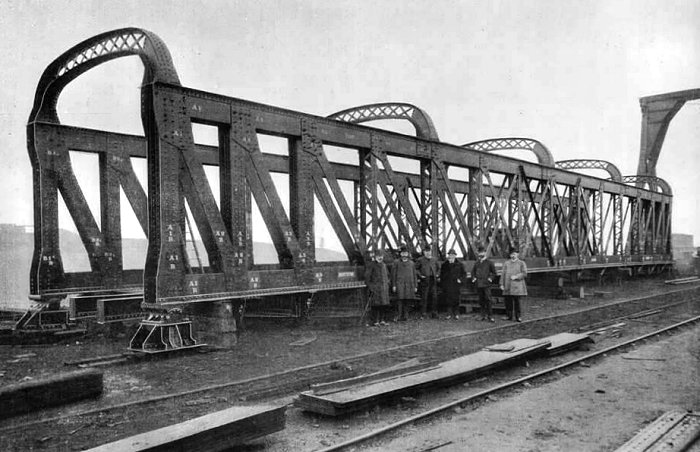
One of the spans built for the
bridge over the Tugela River in South Africa, by the
Patent Shaft in 1899. |

The old Patent Shaft turntable
that is in the town of Realicó, in the province of La
Pampa, Argentina. Courtesy of Arch. Néstor D. Dalmasso. |
|

The makers plate that is on the
turntable above. Courtesy of Arch. Néstor D. Dalmasso. |
|
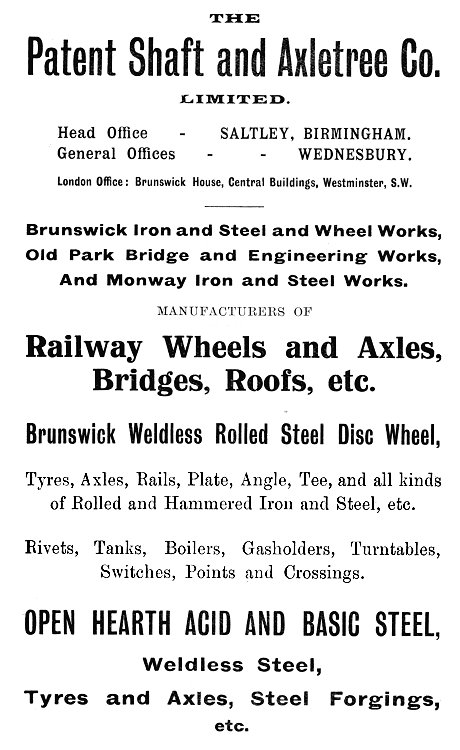
An advert from 1916. |
During the First World War the
company concentrated on war work, and as a result made
record profits. Products included gun carriages, railway
mountings, and tanks. The tanks were built at Old Park
Works, and shell steel was produced at Brunswick Works.
In 1919 it was decided that the
whole of the wagon-building side of the business at Old
Park Works should be managed by the Metropolitan
Company, and the bridgework and other activities carried
on there by Patent Shaft gradually diminished.
In 1919 the Metropolitan Company
was purchased by Vickers Limited of Sheffield, and in
1929 Vickers Limited and Cammell Laird & Company of
Birkenhead, amalgamated their steel making and carriage
building businesses.
This resulted in the formation of
the Metropolitan Cammell Railway Carriage and Wagon
Company. The take
over had one immediate effect at Wednesbury, the
separation of Old Park Works and the Patent Shaft.
Vickers, who had already been using part of Old Park
Works took over the remainder.
In the early 1920s it was also
decided that the manufacture of wheels, tyres, and axles
at should take place at Taylor Bros & Company Limited,
at Trafford Park, later a subsidiary of English Steel
Corporation. That side of the company's business
gradually diminished and finally ceased, so that
steelmaking and rolling were its sole remaining
activities. |
|
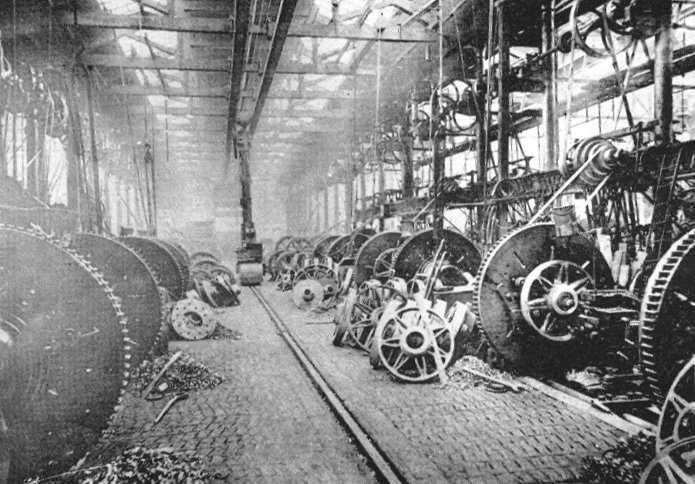
The machine shop in the 1920s.
Development between the wars was
limited, owing to continued depression in the steel
industry, but a new open hearth steel plant, with three
75 ton basic furnaces was added, followed by a fourth furnace in
1938. |

A letterhead from 1929.
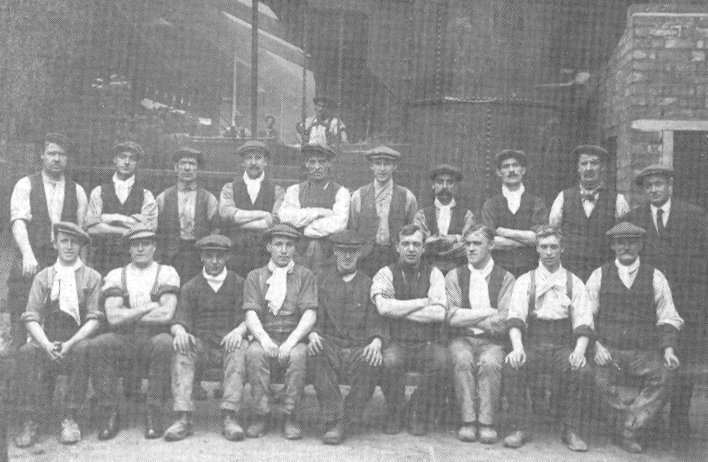
A group of employees.
| A single 40 ton furnace from the old plant was
retained and operated as an acid furnace. A scheme for
the electrification of the 10 inch and 15 inch section
mills, and a new furnace for the 15 inch mill was
finally carried out between 1946 and 1951. In 1949 Old
Park Works were sold outright to Metropolitan Cammell to
become part of the
Metropolitan Cammell Railway Carriage and Wagon Company
Limited, which also had factories at Elmdon, Saltley, and
Washwood Heath.
In 1951 the
company was nationalised under the Iron and Steel Act
1949, but returned to private ownership in 1956 when 75% of its shares were
purchased by Cammell Laird, and the remaining 25% by
Metropolitan Cammell. In 1959 its name was changed to
the Patent Shaft Steel Works Limited, and by 1961 the
company had 1,500 employees.
In the late 1950s a development scheme costing £8.75
million was undertaken with the aid of loans from the
shareholders, and from Finance Corporation for Industry
Limited. As part of the scheme the existing
four 75 ton furnaces were converted from producer gas to
oil firing, and the old 40 ton acid furnace was
scrapped. The 10 inch mill was closed down, and two 75 ton oil fired furnaces were added.
By this time the 15 inch section rolling mill
produced over 300,000 tons of steel a year.
As a result, annual output
increased nearly threefold to over
300,000 tons of ingots, 200,000 tons of plates, and
30,000 tons of bars and sections. |
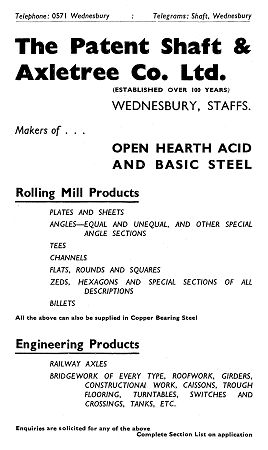
An advert from 1949. |
| Because the company now concentrated on steel
making, its name was changed to The Patent Shaft
Steel Works Limited, on 8th May, 1959. In 1962-63
improved finishing facilities were provided for the
new plate mill, and in 1968-69 new buildings,
cranes, and a reheating furnace for the 15 inch mill
were added. |
|
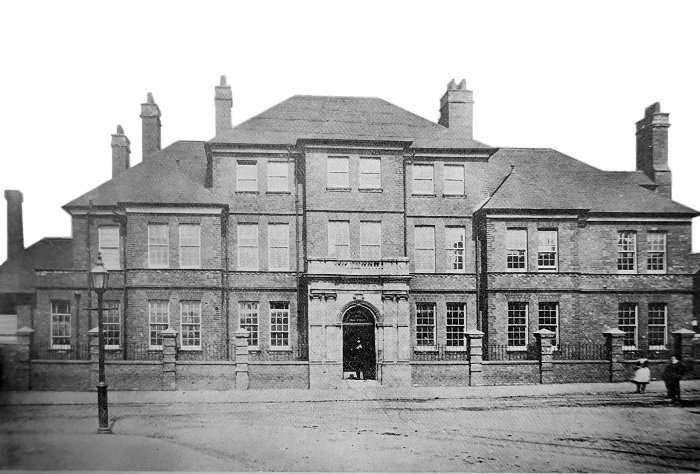
The Patent Shaft offices. |

An advert from 1954.

An aerial view of Patent Shaft's Brunswick
Works.
|
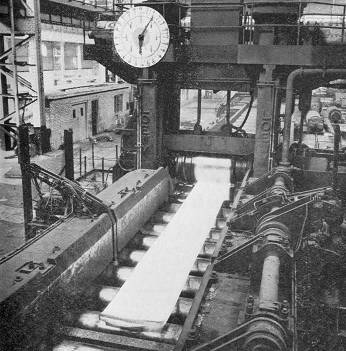
The blooming and slabbing mill at the
steelworks. |
On 1st January, 1969 Cammell Laird acquired
the whole of the Vickers interest in the
Metropolitan Company, so that Patent Shaft
became a wholly-owned subsidiary of Cammell
Laird. Shortly afterwards, the Patent Shaft
share and loan account balances held by the
Metropolitan Company were transferred to the
parent company.
In 1969-70 an additional reheating furnace,
increased slab storage and stacking facilities,
and further improved finishing facilities were
provided for the plate mill, and the steel plant
capacity was increased by strengthening the
building, installing a new 157 ton casting bay
crane and converting the two newer furnaces to
118 tons capacity. Four of the other furnaces
were converted to 98 tons capacity, and the
output greatly increased.
|
|
On 25th September, 1970, following a
reorganisation, Cammell Laird & Company Limited
was renamed The Laird Group Limited. Record
outputs were achieved in 1973 when 372,146
tons of ingots, 233,745 tons of plates, and
43,676 tons of sections were produced. |
 |
|
 |
|
 |
Return to Old
Park Works |
|
Return to the
beginning |
|
Proceed to
Development Schemes |
|